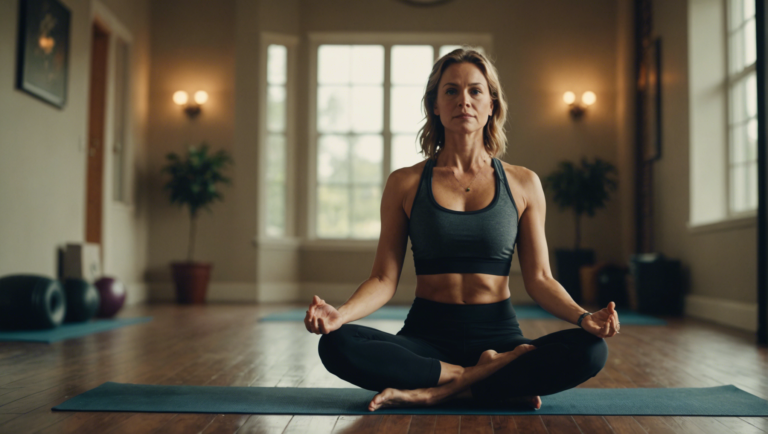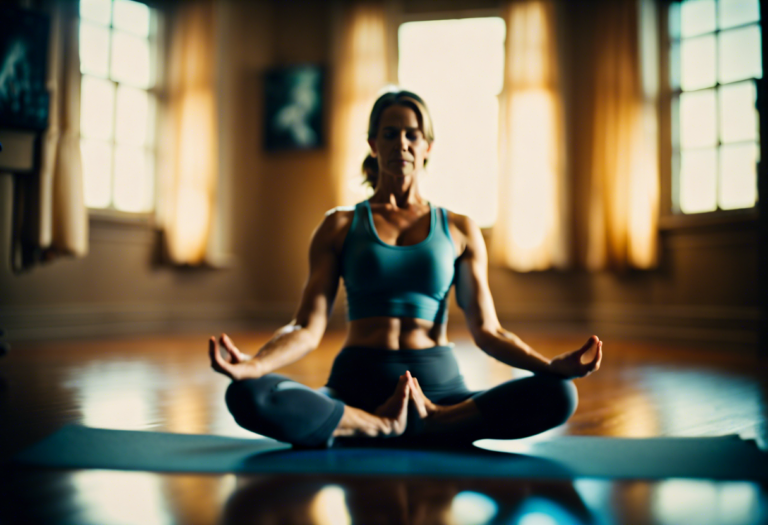Guidelines On How To Effectively Use A Yoga Wheel
Benefits of Incorporating a Yoga Wheel Into Your Practice
Benefits of a Yoga Wheel Into Your Practice
In recent years, yoga wheels have gained popularity in the fitness and yoga community for their versatility and effectiveness in enhancing yoga practices. These cylindrical props offer numerous benefits for practitioners of all levels, from beginners to experienced yogis. a yoga wheel into your practice can help improve flexibility, strength, balance, and even assist in achieving advanced yoga poses. Let’s explore the various advantages of incorporating a yoga wheel into your yoga routine.
Enhanced Stretching and Flexibility
One of the key benefits of using a yoga wheel is its ability to facilitate deep stretching and enhance flexibility. The wheel allows you to safely deepen your stretches by providing support and stability, making it easier to access challenging poses. Whether you are working on backbends, hip openers, or hamstring stretches, the yoga wheel can help you lengthen and release tight muscles, ultimately improving your overall flexibility over time.
Improved Strength Building
In addition to flexibility, incorporating a yoga wheel into your practice can also help build strength, particularly in the core, arms, and back muscles. By using the wheel as a prop in various poses, such as plank, boat pose, or side plank, you engage different muscle groups to maintain stability and balance. This added resistance helps strengthen the muscles, leading to improved overall strength and endurance.
Better Balance and Stability
Balancing poses are essential in yoga as they not only improve physical stability but also cultivate mental focus and concentration. The yoga wheel can be a valuable tool for enhancing balance and stability in standing, seated, and inverted poses. By incorporating the wheel into your balance practice, you challenge your proprioception and core strength, ultimately refining your ability to find stability both on and off the mat.
Assists in Achieving Advanced Poses
For those looking to advance their yoga practice and explore more challenging poses, the yoga wheel can be a game-changer. Poses such as backbends, inversions, and arm balances can be made more accessible with the support of the wheel. It can help you gradually progress into deeper variations of poses, allowing you to safely expand your practice and explore new horizons in yoga.
Relieves Tension and Stress
Beyond the physical benefits, incorporating a yoga wheel into your practice can also help alleviate tension and stress in the body. Rolling on the wheel can provide a relaxing massage-like effect on the spine, releasing tightness in the back muscles and promoting overall relaxation. This gentle traction and mobilization of the spine can help reduce stiffness and promote feelings of rejuvenation and well-being.
The yoga wheel is a versatile prop that offers a wide range of benefits for yogis of all levels. By incorporating the wheel into your practice, you can enhance your flexibility, strength, balance, and overall well-being. Whether you are aiming to deepen your stretches, build strength, or advance your practice, the yoga wheel can be a valuable companion on your yoga journey. Embrace the benefits of the yoga wheel and unlock new possibilities in your yoga practice.
Proper Techniques for Using a Yoga Wheel Safely and Effectively
Yoga wheels have become increasingly popular in the practice of yoga due to their ability to deepen stretches, improve flexibility, and enhance balance. However, using a yoga wheel improperly can lead to injury. To ensure a safe and effective practice, it is essential to understand the proper techniques for using a yoga wheel.
Importance of Proper Technique
When using a yoga wheel, it is crucial to prioritize proper technique to prevent strain or injury. By following guidelines on how to use a yoga wheel effectively, you can maximize its benefits while minimizing the risk of harm.
Choosing the Right Wheel
Before using a yoga wheel, ensure you select the right one for your body and skill level. Yoga wheels come in various sizes and materials, so choose one that feels comfortable and supportive. Beginners may prefer larger wheels for added stability, while more advanced practitioners might opt for smaller wheels for increased challenge.
Warm-Up and Preparation
Before incorporating the yoga wheel into your practice, warm up your body with gentle stretches to prepare your muscles and joints. Focus on areas that will be targeted during your wheel exercises to prevent injury and enhance flexibility.
Basic Poses with a Yoga Wheel
1. Backbends:
- Sit on the floor with the wheel behind you.
- Slowly roll back, placing the wheel under your mid to upper back.
- Use your feet to push the wheel away from you, extending your spine over the wheel.
2. Chest Opener:
- Lie on your back with the wheel positioned beneath your shoulder blades.
- Extend your arms out to the sides for a deep chest stretch.
- Relax into the pose, focusing on deep breathing and relaxation.
Advanced Poses with a Yoga Wheel
1. Forearm Stand:
- Begin in a forearm plank position with the wheel in front of you.
- Lift your hips and walk your feet towards your elbows.
- Engage your core and slowly lift your legs off the ground, finding balance on the wheel.
2. Side Plank:
- Position the wheel under your bottom hand in a side plank position.
- Lift your hips to create a straight line from head to heels.
- Engage your core and hold the pose, focusing on stability and strength.
Safety Tips
- Listen to your body and avoid pushing yourself past your limits.
- Ensure the wheel is placed on a flat, non-slip surface to prevent accidents.
- Engage your core muscles to support your spine and prevent straining.
Using a yoga wheel can amplify your yoga practice by providing new challenges and opportunities for growth. By following proper techniques and safety guidelines, you can safely and effectively incorporate the yoga wheel into your routine. Remember to start slowly, listen to your body, and enjoy the journey of exploration and self-discovery that the yoga wheel can offer.
Yoga Wheel Exercises to Improve Flexibility and Strength
Yoga wheels have become increasingly popular in the world of fitness and yoga for their ability to enhance flexibility, improve strength, and deepen stretches. a yoga wheel into your practice can take your yoga routine to the next level by targeting muscles that are often hard to reach. Here are some effective guidelines on how to use a yoga wheel to its full potential.
Understanding Proper Alignment:
When using a yoga wheel, it is crucial to maintain proper alignment to prevent injury and maximize the benefits of the exercises. Start by placing the wheel on the mat and aligning your spine with the center of the wheel. This alignment will help you engage the right muscles and avoid unnecessary strain on your body.
Warm-Up and Cool Down:
Before diving into more advanced poses with the yoga wheel, it’s essential to warm up your body properly. Perform some gentle stretches and basic yoga poses to prepare your muscles for the deeper stretches using the wheel. Similarly, after your practice, take the time to cool down with some calming stretches to prevent muscle soreness.
Enhancing Core Strength:
One of the key benefits of using a yoga wheel is its ability to strengthen the core muscles. Try incorporating exercises like wheel planks, pikes, and knee tucks to engage your core muscles effectively. These exercises not only improve your core strength but also help stabilize your entire body during yoga poses.
Deepening Backbends:
Yoga wheels are excellent tools for deepening backbends and improving spine flexibility. To safely enhance your backbends with the wheel, start with gentle stretches and gradually work your way up to more advanced poses like wheel pose (Chakrasana) and camel pose. The wheel provides support and allows you to access deeper backbends with proper alignment.
Improving Balance and Stability:
Using a yoga wheel can also help improve your balance and stability by challenging your core muscles and proprioception. Incorporate balance exercises such as standing on the wheel with one foot or practicing one-legged poses with the support of the wheel. These exercises not only enhance your physical stability but also build mental focus and concentration.
Relaxation and Release:
In addition to strengthening and stretching, a yoga wheel can be used for relaxation and muscle release. Lie on your back with the wheel supporting your legs in a gentle inversion to release tension in the lower back and hamstrings. You can also use the wheel to massage the back and shoulders by rolling back and forth gently.
:
Incorporating a yoga wheel into your practice can significantly enhance your yoga experience by improving flexibility, strengthening muscles, and deepening stretches. By following these guidelines on how to effectively use a yoga wheel, you can unlock a wide range of benefits for your body and mind. Remember to listen to your body, practice mindfully, and enjoy the journey of exploring new possibilities with the yoga wheel.
How to Choose the Right Yoga Wheel for Your Needs
Using a yoga wheel can greatly enhance your yoga practice by providing support, stability, and helping you deepen your stretches. However, with various options available in the market, it can be overwhelming to choose the right yoga wheel that suits your needs. Here are some guidelines on how to effectively select the perfect yoga wheel for your practice:
Understanding the Different Types of Yoga Wheels
When it comes to yoga wheels, there are typically three main types: basic plastic yoga wheels, cork yoga wheels, and padded yoga wheels. Basic plastic yoga wheels are durable and provide a sturdy surface for your practice. Cork yoga wheels are eco-friendly, antimicrobial, and offer a comfortable grip. Padded yoga wheels are covered with foam or cushioning, providing extra support and comfort during your practice. Consider the material that aligns with your preferences and needs.
Determining the Size of the Yoga Wheel
Yoga wheels come in various sizes, typically ranging from 6 to 15 inches in diameter. The size of the yoga wheel you choose should correspond to your height, flexibility level, and intended use. Larger wheels are suitable for taller individuals and offer more support for backbends and inversions. Smaller wheels are more portable and convenient for travel or targeted muscle release. Select a size that complements your body and practice requirements.
Checking the Weight Capacity
Before purchasing a yoga wheel, it’s essential to check the weight capacity specified by the manufacturer. Most yoga wheels can support a weight range of 200 to 500 pounds. Ensure that the yoga wheel you choose can accommodate your body weight to prevent any accidents or damage to the wheel during your practice.
Assessing the Wheel Surface
The surface texture of the yoga wheel plays a crucial role in providing grip and stability during poses. Some yoga wheels have a smooth surface, while others feature ridges or patterns for enhanced traction. If you sweat during your practice or prefer a more secure grip, opt for a yoga wheel with a textured surface to prevent slipping and sliding.
Considering Additional Features
Some yoga wheels come with extra features such as eco-friendly materials, sweat-resistant properties, and detachable padding. These additional features can enhance your overall yoga experience and cater to specific preferences or needs. Prioritize the features that align with your values and requirements to make the most out of your yoga wheel investment.
Seeking Recommendations and Reviews
Before making a final decision, take the time to read reviews and seek recommendations from fellow yogis or instructors. Their insights and experiences can provide valuable guidance in selecting a high-quality yoga wheel that meets your expectations and enhances your practice.
Choosing the right yoga wheel is a personal decision that should consider factors such as material, size, weight capacity, surface texture, additional features, and user reviews. By following these guidelines and conducting thorough research, you can confidently select a yoga wheel that supports your practice and helps you achieve your yoga goals.
Combining Yoga Wheel Workouts with Other Yoga Practices for Enhanced Benefits
Yoga wheels have become a popular tool in yoga practices due to their ability to deepen stretches, improve flexibility, and enhance core strength. When combined with other yoga practices, such as Hatha, Vinyasa, or Restorative yoga, the benefits can be further amplified, leading to a more holistic approach to physical and mental well-being.
Benefits of Combining Yoga Wheel Workouts with Other Yoga Practices
By integrating the use of a yoga wheel with traditional yoga routines, practitioners can experience a range of benefits that contribute to overall fitness and wellness. The yoga wheel allows for greater extension in poses, helping to lengthen and strengthen muscles that may be difficult to target otherwise. This additional support can also assist in improving balance and stability during challenging poses.
the Yoga Wheel in Hatha Yoga
Hatha yoga focuses on the practice of asanas or postures to align the body and mind. When using a yoga wheel in Hatha yoga, practitioners can explore new variations of familiar poses such as Downward Facing Dog, Cobra, or Forward Fold. The wheel can help deepen the stretch in backbends, open up the shoulders, and provide support in balancing poses.
Enhancing Vinyasa Flows with the Yoga Wheel
Vinyasa yoga is a dynamic practice that links movement with breath. Integrating the yoga wheel into Vinyasa flows can add an element of challenge and creativity to the practice. Practitioners can incorporate the wheel in transitions between poses, use it as a prop for arm balances, or even as a tool for meditation and relaxation at the end of a sequence.
Restorative Yoga Practices with the Yoga Wheel
Restorative yoga focuses on relaxation and stress relief through supported poses and gentle stretches. When combined with a yoga wheel, restorative poses can become even more restful and rejuvenating. The wheel can provide additional support in passive backbends, hip openers, and spinal twists, allowing for a deeper release of tension and a greater sense of ease.
Tips for Safely Using the Yoga Wheel in Combination with Other Yoga Practices
To ensure a safe and effective practice when combining the yoga wheel with other yoga disciplines, it is important to follow these guidelines:
- Start slowly and gradually introduce the wheel into your practice to allow the body to adjust to the new tool.
- Listen to your body and modify poses as needed to prevent overstretching or strain.
- Seek guidance from a qualified yoga instructor to learn proper alignment and technique when using the wheel.
- Incorporate the wheel mindfully, focusing on proper breathing and body awareness throughout your practice.
- Enjoy the journey of exploration and discovery as you deepen your yoga practice with the versatile yoga wheel.
By integrating the use of a yoga wheel with other yoga practices, practitioners can unlock new dimensions of their practice, promote functional strength, and cultivate a deeper connection between the body and mind. Whether you are a beginner or an experienced yogi, experimenting with the yoga wheel can bring about a sense of playfulness and exploration to your yoga journey.
Conclusion
A yoga wheel into your practice can bring a myriad of benefits to your overall well-being. The advantages span from improving flexibility and strength to enhancing balance and alignment in your yoga poses. By utilizing the proper techniques, you can ensure a safe and effective practice with the yoga wheel. Remember to start slowly, listen to your body, and gradually progress to more advanced exercises to avoid injuries and reap the full benefits of this versatile yoga prop.
When using a yoga wheel, it is vital to maintain proper form and alignment to prevent strain or injury. Focus on engaging your core muscles, keeping your spine neutral, and breathing deeply throughout each movement. By following these techniques, you can enhance your practice and deepen your stretches, leading to increased flexibility and strength over time.
To optimize your yoga wheel workouts, incorporate a variety of exercises that target different muscle groups and areas of the body. From backbends and chest openers to core strengtheners and hip openers, the possibilities are endless with a yoga wheel. Experiment with various poses and sequences to discover what works best for your body and goals.
When choosing a yoga wheel, consider factors such as size, material, and durability to ensure it meets your specific needs and preferences. Whether you are a beginner or an experienced yogi, selecting the right yoga wheel can enhance your practice and provide added support and stability during challenging poses.
To maximize the benefits of using a yoga wheel, consider combining wheel workouts with other yoga practices such as Hatha, Vinyasa, or Yin yoga. By integrating the wheel into your routine, you can deepen your stretches, improve your balance, and challenge your strength in new ways. Explore creative sequences and flow smoothly between poses to create a holistic and effective yoga practice.
Incorporating a yoga wheel into your yoga practice can revolutionize the way you approach your workouts and enhance your overall well-being. By understanding the benefits, practicing proper techniques, exploring different exercises, choosing the right wheel, and combining workouts with other yoga practices, you can unlock new levels of flexibility, strength, and balance. Embrace the versatility of the yoga wheel and embark on a journey of self-discovery and transformation on and off the mat.


